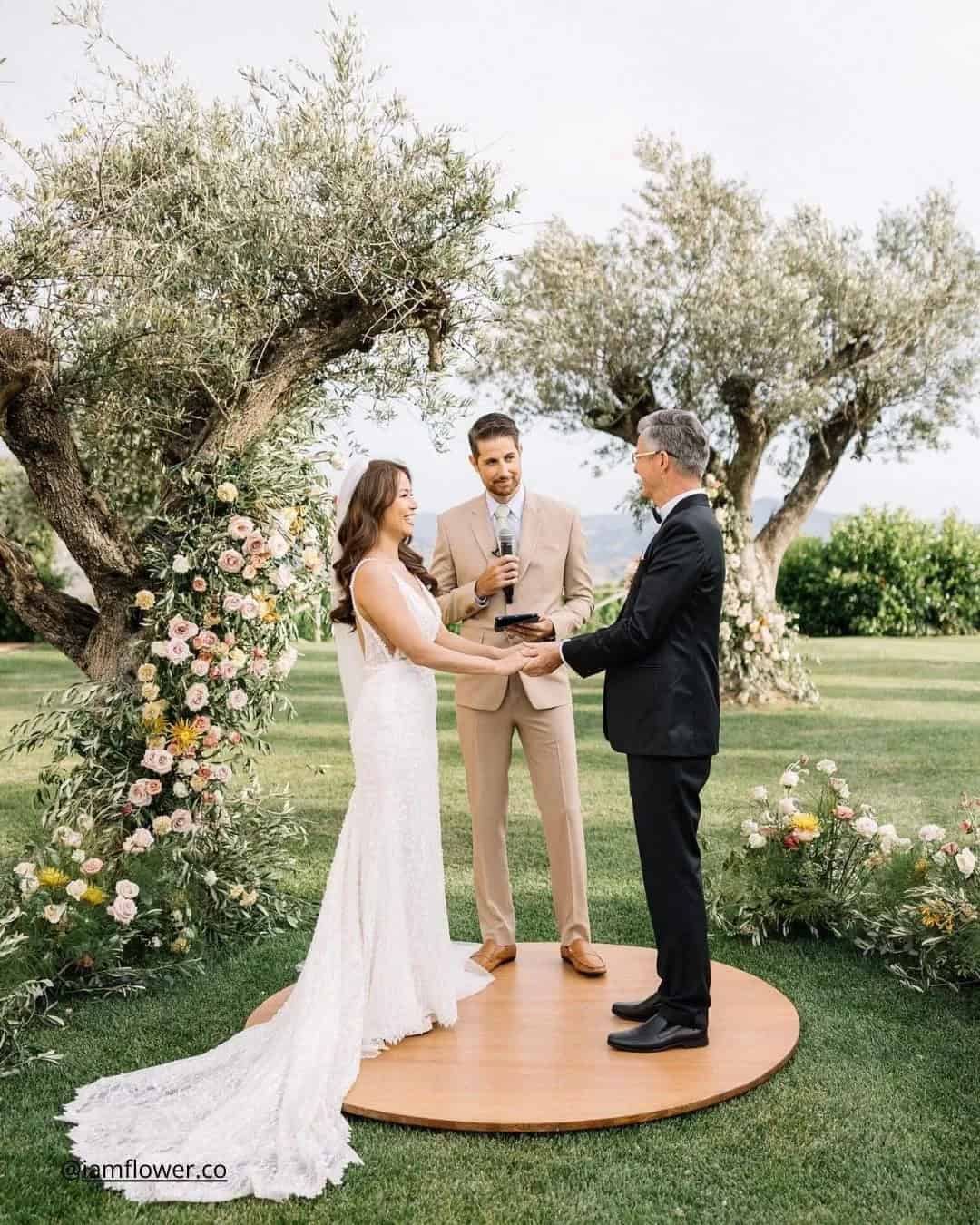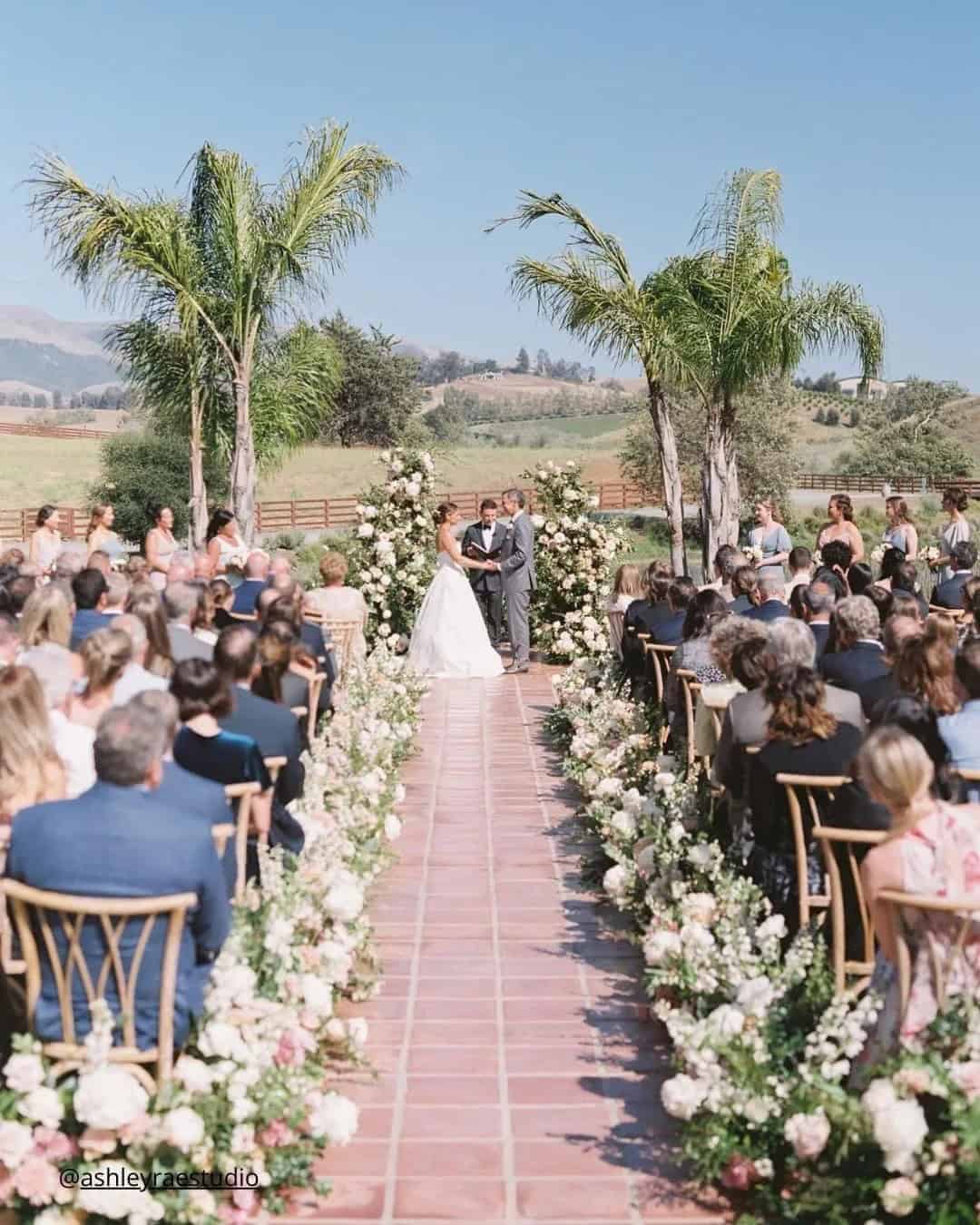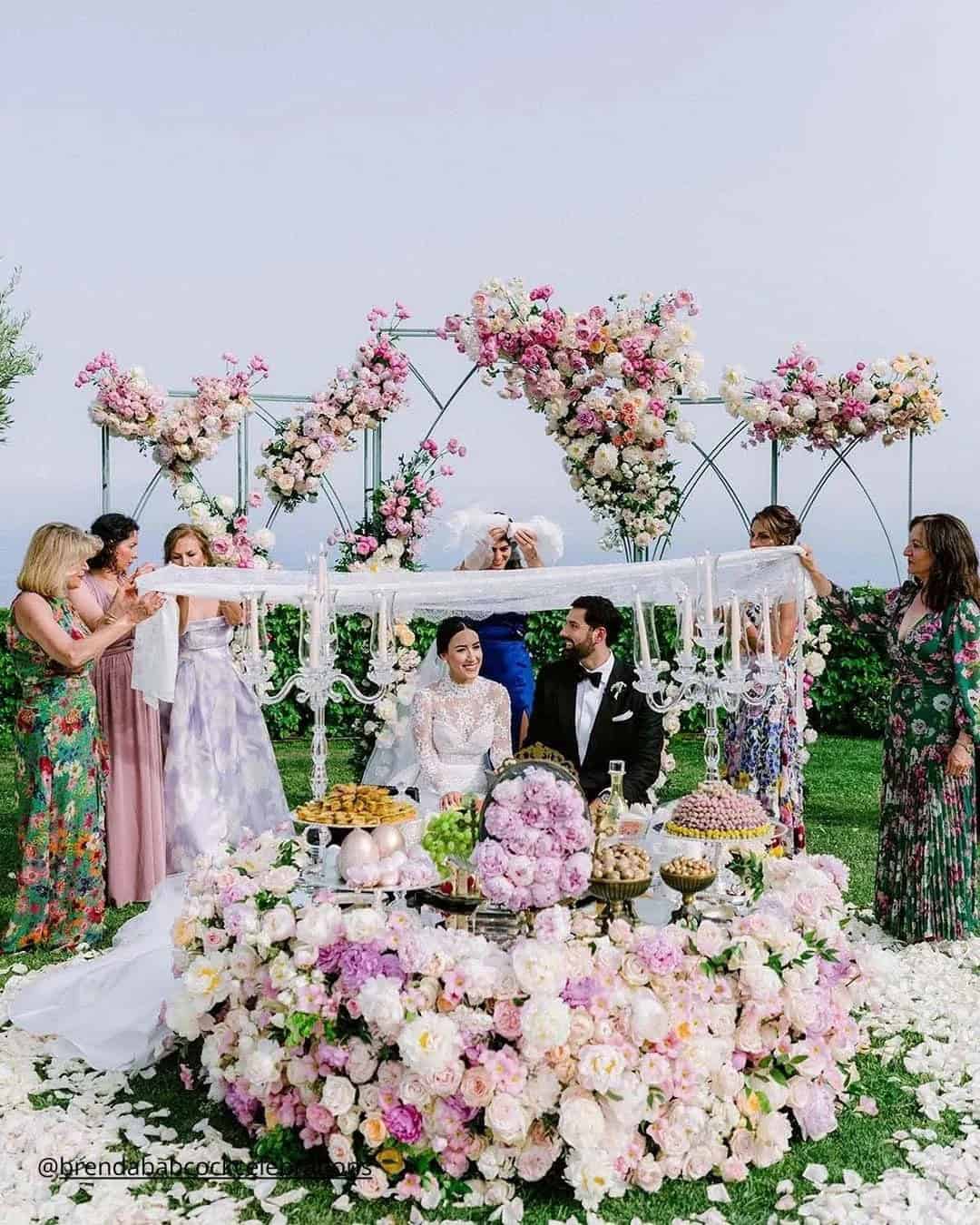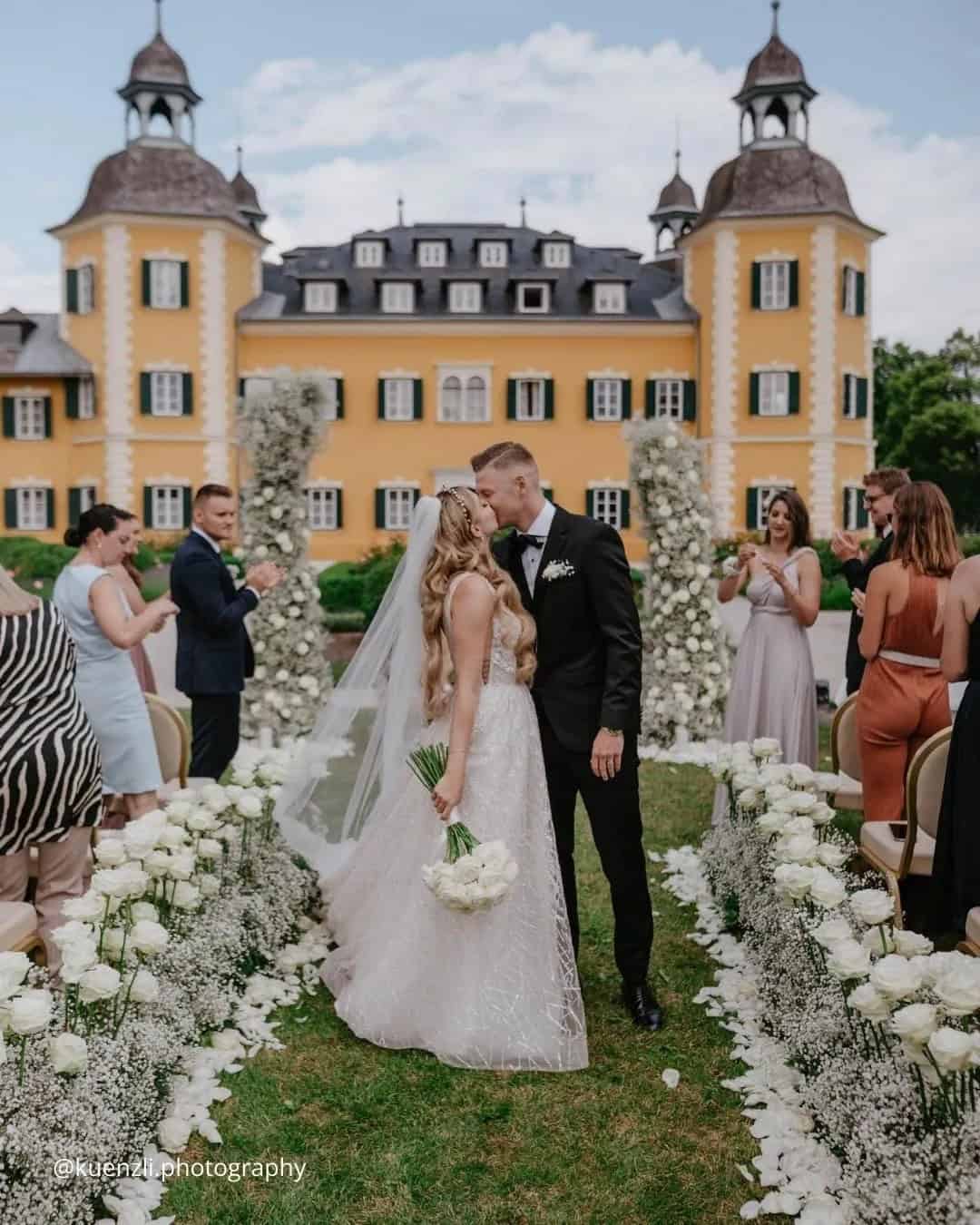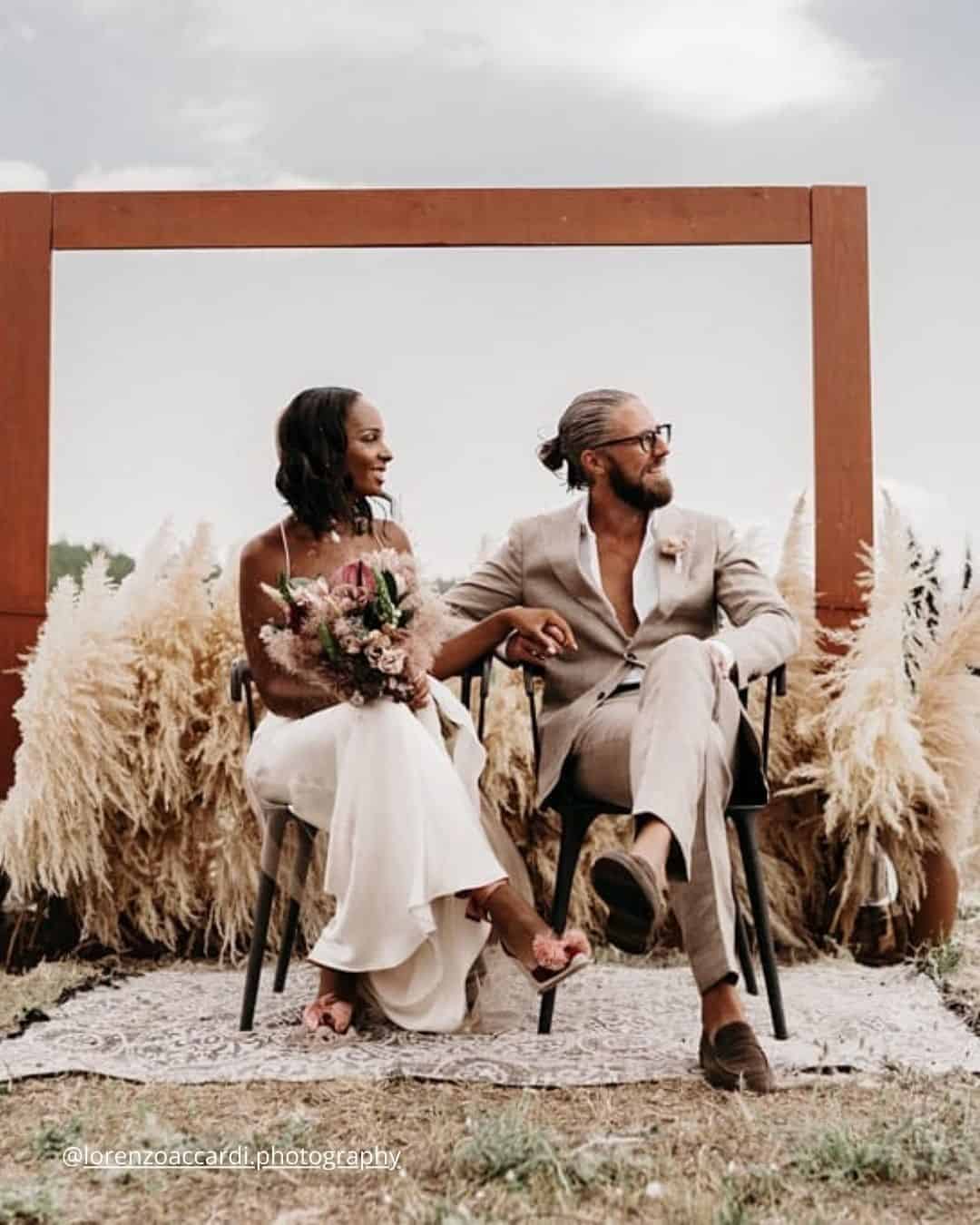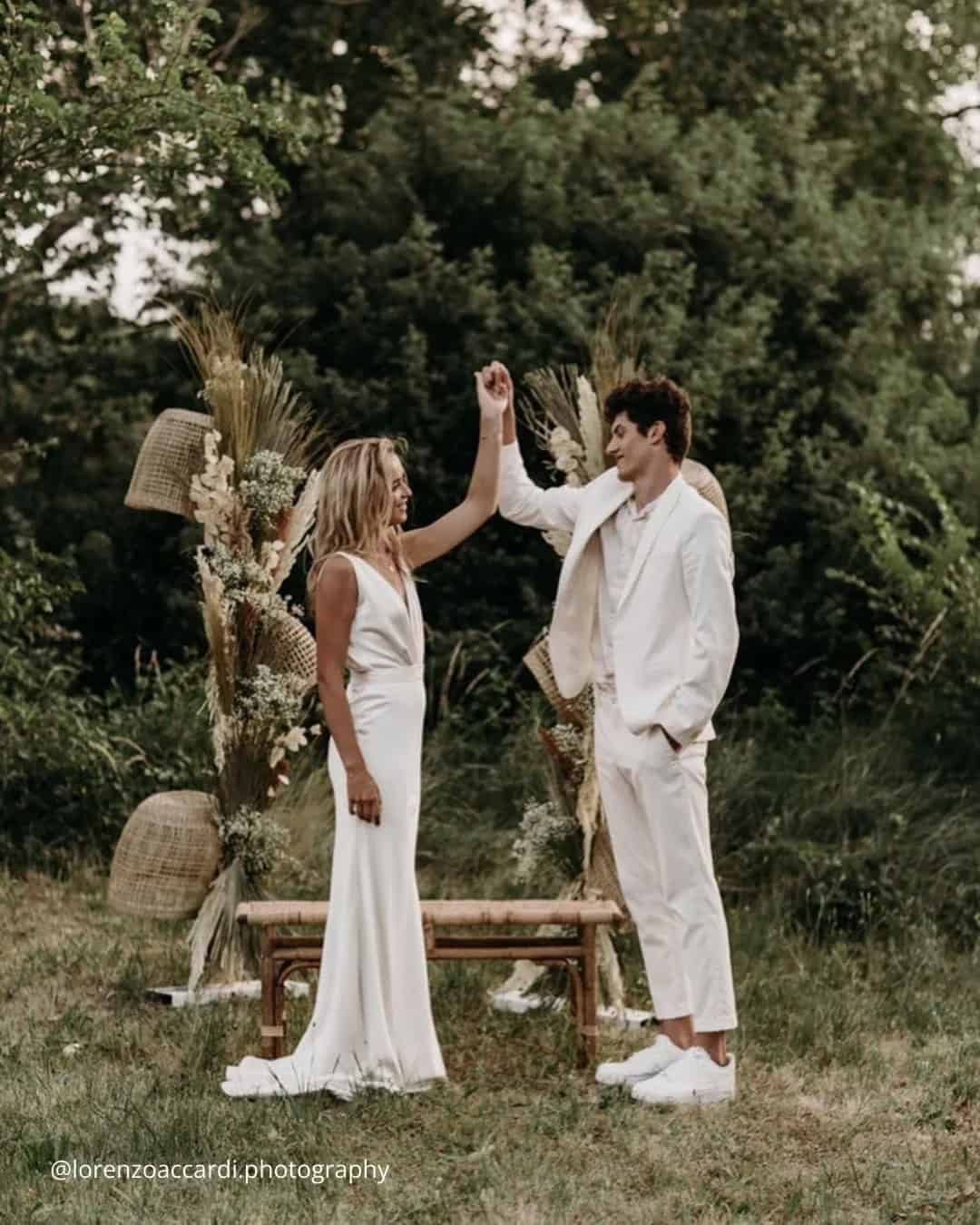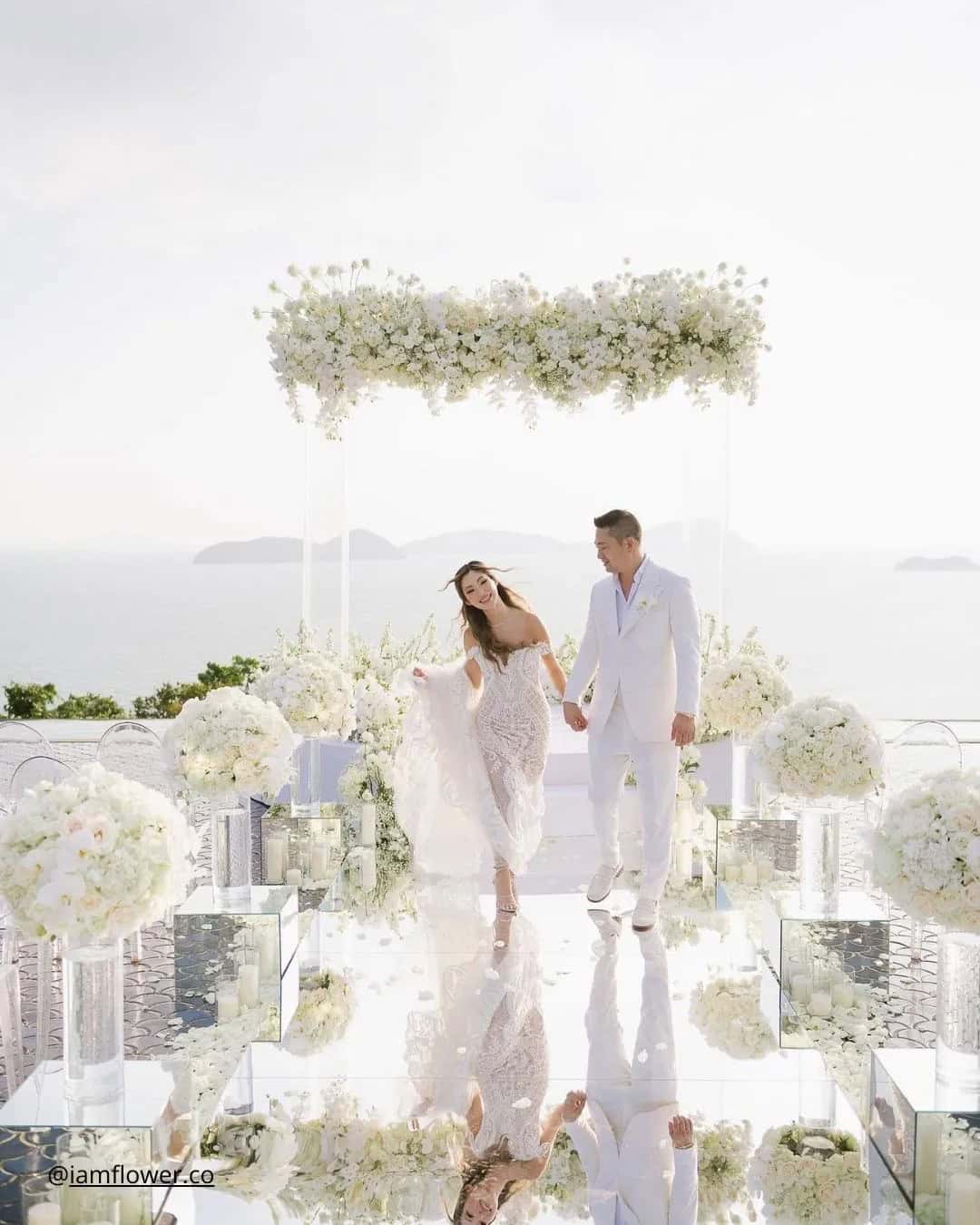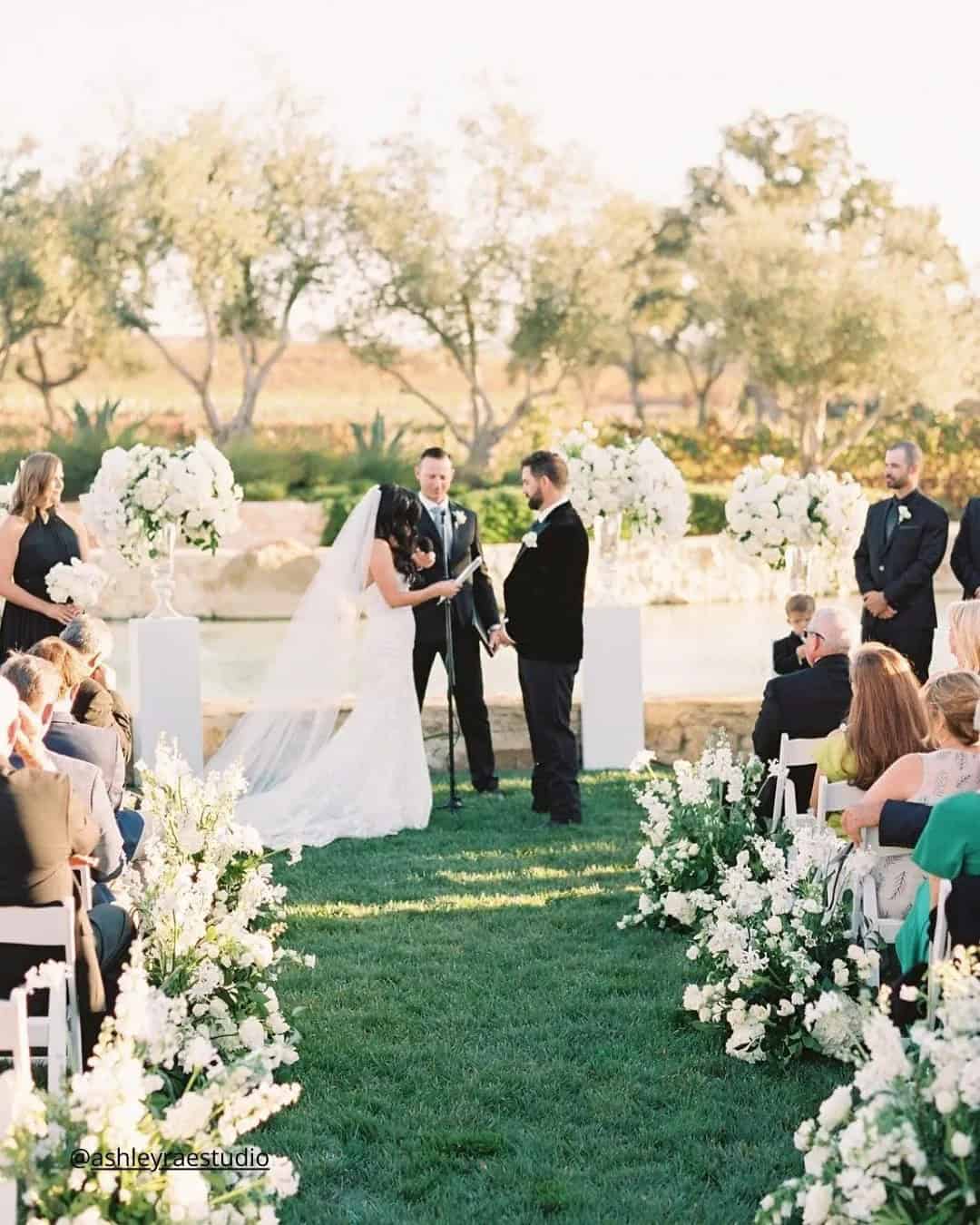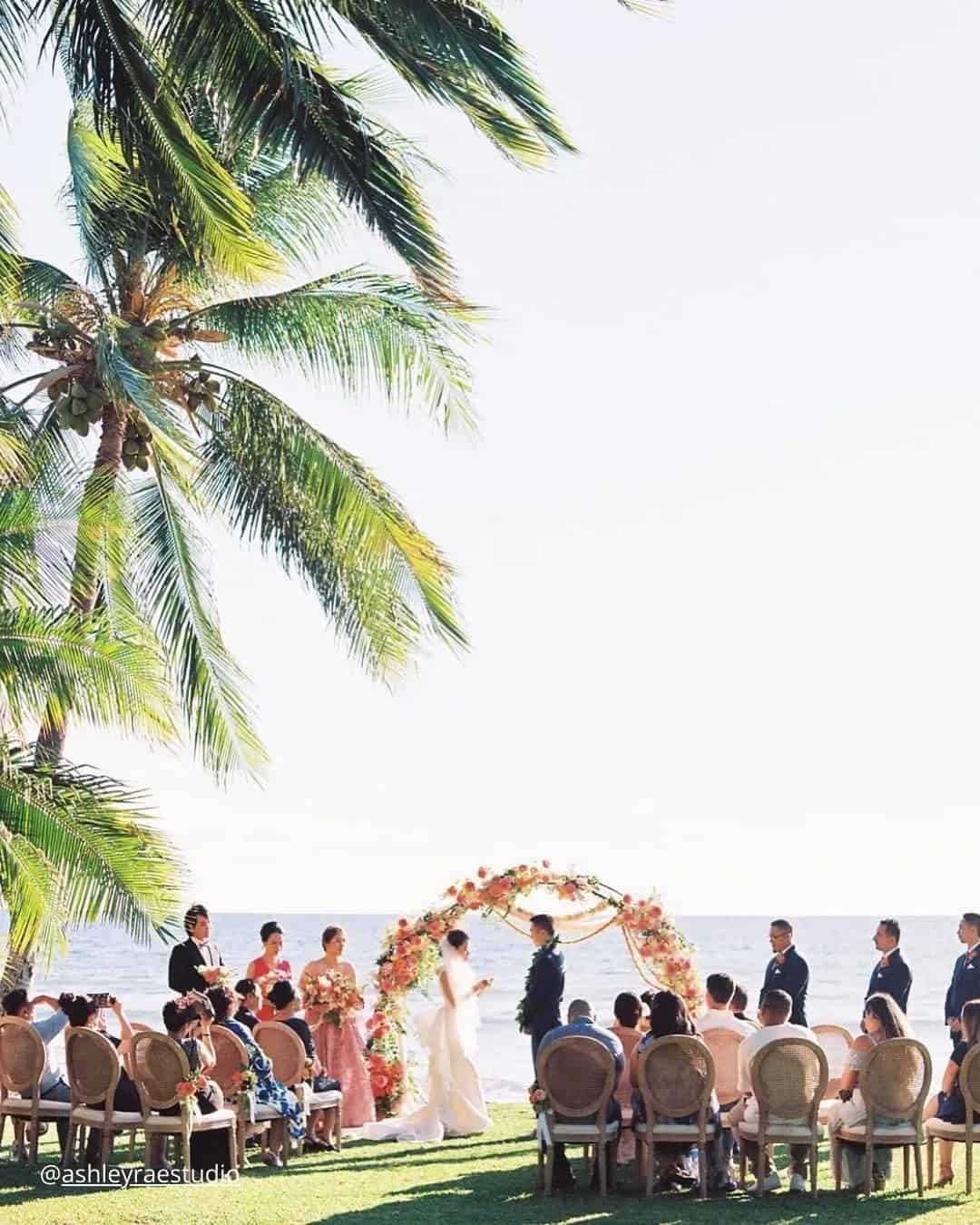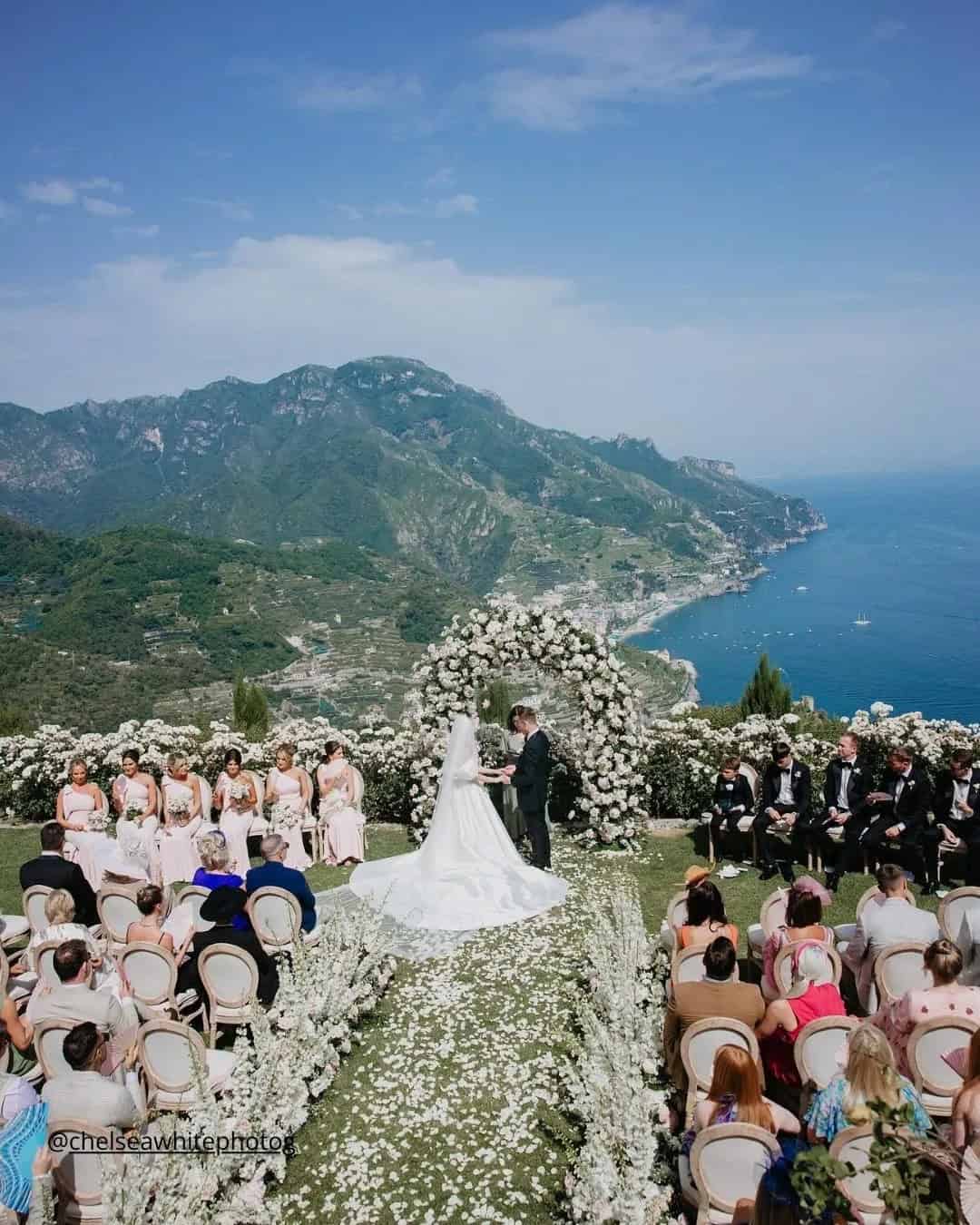A wedding ceremony is a momentous occasion where love, commitment, and new beginnings are celebrated. To make your special day truly unforgettable, consider infusing it with a theme that reflects your personality and shared interests. With an abundance of options to choose from, you’re spoiled for choice when it comes to selecting the perfect blend of tradition and modernity.
Your wedding is a reflection of your unique love story, so why not let your imagination run wild and create a ceremony that’s as distinctive as you are? As you embark on this new chapter, remember that every detail matters. From the music to the readings, the program to the script, every element contributes to an experience that will be cherished by you and your loved ones for years to come.
Frequently Asked Questions
How long is a wedding ceremony?
A wedding ceremony’s duration is largely influenced by its type and style. On average, a non-religious ceremony typically lasts around 20-30 minutes. In contrast, religious ceremonies tend to be longer. However, the length of the ceremony can fluctuate depending on various factors, including cultural or religious traditions and personal preferences. Ultimately, couples should collaborate with their officiant to craft a timing that honors their unique vision.
Wedding Ceremony Ideas
As couples prepare to exchange their vows, they often seek ways to make their special day truly unforgettable. With countless wedding ceremony ideas to explore, the key lies in finding a theme that authentically reflects their personality and style. From traditional to unique and creative approaches, selecting a meaningful theme is an essential aspect of planning a memorable marriage ceremony.
Popular themes include rustic, bohemian, garden, beach, and vintage, offering endless possibilities for incorporating your chosen theme into decorations such as flowers, centerpieces, and lighting. This cohesive look and feel will undoubtedly create a lasting impression on guests. Furthermore, selecting the right officiant is crucial – whether it’s a religious leader, close friend or family member, or professional officiant – to lead the ceremony with sincerity and authority.
To personalize your special day, couples can write their own vows, select meaningful readings or music, or incorporate rituals and traditions that hold significance. Additionally, pre-wedding ceremonies such as first looks or unity ceremonies like sand ceremonies or handfasting offer unique ways to symbolize the joining of two souls.
Wedding Ceremony Types
As couples prepare to tie the knot, they often find themselves pondering the perfect way to make their vow exchange official. For some, tradition is the name of the game, while others prefer to break free from conventions and forge their own path. The results are in – 20.54% of respondents opted for a traditional ceremony, 30.62% chose non-traditional, 13.57% went with a religious ceremony, 34.88% selected cultural, and a mere 0.39% voted to see the results.
With over 258 votes cast, it’s clear that couples are eager to put their own unique spin on this momentous occasion. From traditional customs and rituals to non-traditional ceremonies that allow couples to express themselves freely, there’s no shortage of options. For some, a religious ceremony provides a sense of comfort and familiarity, often taking place in a place of worship like a church or mosque, with religious readings and prayers woven throughout.
Others may prefer a non-religious ceremony, which can take place in secular venues and incorporate more personal touches, such as poetry or music. But what about cultural ceremonies? Weddings around the world are steeped in unique customs and rituals that add flavor and depth to this special day.
For instance, Hindu weddings might include the Mehndi ceremony, where the bride’s hands and feet are adorned with henna, while Jewish weddings often feature the signing of the Ketubah, a marriage contract, as well as the breaking of glass at the end of the ceremony. In recent years, same-sex weddings have become increasingly popular, bringing their own set of traditions and rituals to the table. Think rainbow-colored rings or a drag queen performance – the possibilities are endless!
Ultimately, the most important thing is that couples create a ceremony that truly reflects their love and commitment to one another, regardless of the type.
Wedding Ceremony Outline
A wedding ceremony typically unfolds according to a tried-and-true framework, but couples can thoughtfully infuse it with their unique personality, cultural heritage, and personal style. From the processional, where the wedding party makes its grand entrance, to the pronouncement of marriage, when the couple is officially sealed as one, every moment counts.
Key moments include the introduction by the officiant, who sets the tone for the celebration; opening remarks that might highlight the couple’s love story or the significance of the day; and the exchange of vows and rings, a poignant expression of their commitment to each other. Additionally, cultural elements such as traditional dress, music, or dances can add depth and authenticity to the ceremony.
Ultimately, working closely with the officiant or wedding planner is crucial to crafting a wedding ceremony that is both meaningful and memorable.
Wedding Ceremony Program
A wedding ceremony program serves as a comprehensive guide for guests, providing an outline of events and essential details.
The core components of such a program typically encompass: a cover page featuring the couple’s names, date, location, and other crucial information; an introduction offering a brief overview of the ceremony, potentially including messages from the couple or officiant; an order of events listing the key elements, including processional, opening remarks, exchange of vows, ring exchange, pronouncement of marriage, and recessional.
Additionally, the program may include the wedding party roster, comprising maid of honor, best man, bridesmaids, groomsmen, and other vital participants. A heartfelt thank you note from the couple to their guests for sharing in their special day is also a common feature. When choosing a ceremony program, it’s essential to consider the wedding’s style and tone, ensuring that the design is easy to read and comprehend.
A well-crafted program can add a personal touch to the celebration and serve as a treasured keepsake for attendees.
Wedding Ceremony Order
The core of every marriage ceremony revolves around a set sequence of events, though flexibility is key as couples tailor their special day to suit their unique preferences and cultural backgrounds. Here’s a general outline of what you can expect during the average wedding ceremony:Guests arrive at the venue, take their seats, and get ready for the proceedings to begin. Next, the wedding party makes its grand entrance, with the bride and her partner bringing up the rear.
The officiant takes the stage, greeting guests, making any necessary announcements, and setting the tone for the celebration to come. As the emotional centerpiece of the ceremony, the couple exchanges their heartfelt vows, pledging their love and commitment to one another. This is followed by the symbolic exchange of rings, a poignant reminder of the enduring bond between the two lovebirds.
With the formalities out of the way, the officiant pronounces the couple husband and wife, sealing their union with a resounding declaration. The ceremony culminates in a romantic kiss, as the newlyweds share a tender moment to mark their new status. Finally, it’s time for the recessional, as guests bid farewell to the happy couple and make their way out of the ceremony area.
Of course, every wedding is unique, and couples often incorporate personal touches, cultural traditions, and family influences into their special day. You might see a sand ceremony or candle lighting, or perhaps even the breaking of glass in a Jewish ceremony or the tying of red string in a Chinese celebration.
Wedding Ceremony Script Ideas
Wedding ceremony scripts offer couples a range of creative possibilities. While traditional scripts maintain a formal tone, modern approaches allow for greater flexibility and personalization. Some couples choose to write their own vows, incorporate literary or poetic readings, or even include non-traditional elements like music or dance performances.
A typical marriage ceremony script comprises several key components:Opening remarks: The officiant sets the tone by welcoming guests and sharing words of wisdom and appreciation. Vow exchange: The couple shares their promises to one another. Ring exchange: This symbolic act represents the couple’s commitment to each other. Unity ceremonies: Some couples opt for unique elements, such as ‘love locks’ or ‘warming of the rings’.
Pronouncement of marriage: The officiant officially declares the couple married. Closing remarks: The officiant may offer final words of wisdom or encouragement to the newlyweds and their guests. For religious ceremonies, additional elements like prayers, hymns, or readings from sacred texts are common. Non-religious scripts, on the other hand, might focus on personalized vows, literary or poetic readings, or symbolic elements that reflect the couple’s values and personalities.
Cultural ceremonies often incorporate traditional elements, such as a ‘chuppah’ in a Jewish wedding or the exchange of floral garlands in an Indian ceremony. When crafting a script for your special day, consider drawing upon personal anecdotes or stories to make it truly unique. You may also want to reflect the tone and theme of your wedding by incorporating cultural, religious, or literary elements that resonate with you as a couple.
Wedding Ceremony Songs and Music
Music plays a vital role in setting the tone and elevating the emotional experience for the newlyweds and their guests. It has the power to evoke strong emotions, create lasting memories, and leave a lasting impression. When curating the perfect wedding ceremony playlist, consider the different segments of the ceremony, such as the processional, recessional, and any special interludes that require unique musical accompaniment.
Lyrics become an important factor in song selection, with some couples opting for more subtle choices to avoid overwhelming sentimentality, while others may intentionally choose songs that resonate deeply with their love story. Popular options include timeless classical pieces like Pachelbel’s Canon in D and Mendelssohn’s Wedding March, as well as contemporary tracks that hold personal significance for the couple.
To add an extra layer of intimacy, some couples may also choose to incorporate live music or a choir into their ceremony, making it a truly one-of-a-kind celebration.
Wedding Ceremony Readings
In wedding ceremonies, readings play a vital role in conveying the couple’s values, beliefs, and love for each other. They also provide an opportunity for close friends or family members to share their thoughts and well-wishes. These readings serve as a poignant reminder of the significance of marriage and the commitment being made. When choosing readings for a wedding ceremony, it’s crucial to consider the couple’s beliefs, values, and preferences.
This ensures that the selected readings align with their vision and tone for the occasion. There are three primary types of readings that can be incorporated into a wedding ceremony: religious, non-religious, and cultural. Religious readings can be drawn from sacred texts and reflect the couple’s faith, while non-religious readings might include poetry, literature, or personal reflections.
Cultural readings, on the other hand, can reflect the couple’s heritage and bring a sense of identity and pride to the ceremony. It’s essential for the couple to collaborate with their officiant and any readers to ensure that the length of the readings fits within the overall timeline of the ceremony. By doing so, they can create a seamless and meaningful experience for themselves and their guests.
Wedding Ceremony Venues
When it comes to selecting a wedding ceremony venue, couples must weigh multiple factors to ensure their big day exceeds expectations. To start, they should consider their shared vision for the wedding, including the style, location, and atmosphere they envision. Budget and guest count also play critical roles in this decision-making process. Moreover, couples may require special accommodations or have specific needs that must be addressed.
Indoor venues like churches, ballrooms, museums, and libraries offer convenience and amenities, while outdoor options such as gardens, beaches, parks, and vineyards provide a natural, romantic ambiance. Destination weddings can also be a unique and unforgettable experience, but they demand more planning and logistical coordination. The venue’s location and accessibility are crucial considerations, ensuring that guests can easily travel to the ceremony site.
To make an informed decision, couples should schedule in-person visits, meet with venue coordinators, and review feedback from previous clients. By carefully evaluating these factors, couples can select a venue that aligns with their budget, style, and guest count, ultimately creating a memorable experience for themselves and their loved ones.
